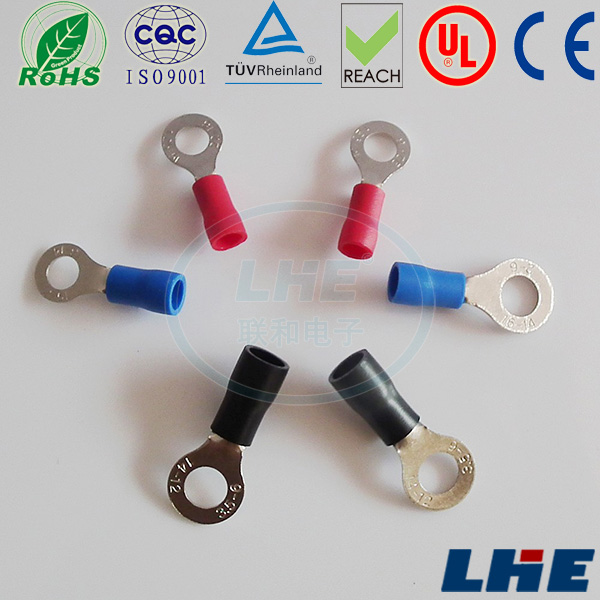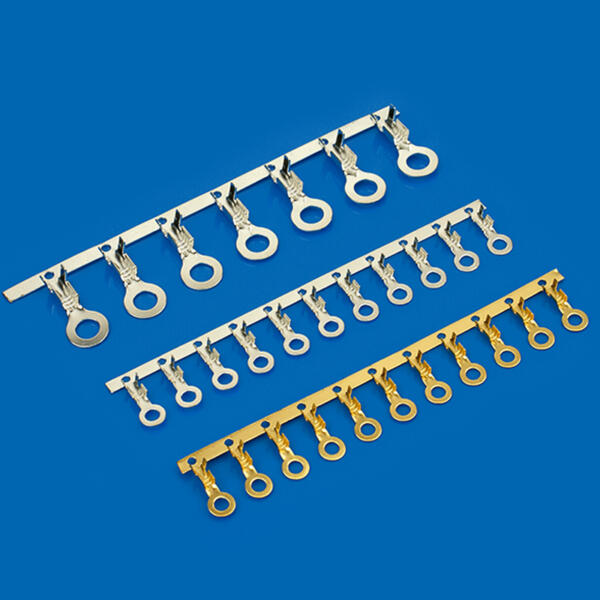In the world of wires, terminals are key components for achieving safe and reliable connections. Among the many types of terminals, ring terminals and spade terminals are the two most widely used in automotive, industrial, and home electrical applications. This article will explore what ring terminals and spade terminals are, their uses, and the differences between them to help you make an informed choice for your next project.
Ring vs Spade Terminals: What’s the Difference?
What Are Ring Terminals?
Ring terminals are circular-shaped connectors used to fasten a wire to a screw or stud-type electrical connection.
The defining feature of a ring terminal is the closed-loop end that ensures the terminal cannot slip off the stud once it’s secured. This provides a highly reliable and vibration-resistant connection.
Ring terminals are typically made of materials such as copper, brass, or tin-plated copper for corrosion resistance. They come in insulated and non-insulated versions and are sized by both the gauge of the wire they accept and the diameter of the ring.
Key Characteristics of Ring Terminals
Secure connection: Once the screw or bolt is fastened through the ring, the wire is locked in place.
Vibration resistant: Ideal for automotive and heavy machinery where movement and vibration are common.
Available in various sizes: To fit a range of wire gauges and stud sizes.
Ring terminals are typically crimped or soldered to the wire and then bolted onto the terminal point, creating a durable electrical connection.
What Are Spade Terminals?
Spade terminals, sometimes referred to as fork terminals, are open-ended connectors shaped like a U or fork. This design allows the terminal to be installed or removed without completely removing the screw — a major convenience in certain settings.
Spade terminals are also manufactured in insulated and non-insulated versions and come in various materials, typically brass or copper with plating for oxidation resistance. The forked shape is especially useful in applications where quick removal or change of wiring is necessary.
Key Characteristics of Spade Terminals
Quick install and removal: The open design allows for connection without removing the screw completely.
Moderate security: Less secure than a ring terminal, as the terminal can potentially slip out if the screw loosens.
Good for tight spaces: Fork shape allows wiring to be installed in close quarters without full disassembly.
Like ring terminals, spade terminals are crimped onto the wire and then placed under the screw for connection.
Where Are Ring and Spade Terminals Used?
Both ring and spade terminals are used across various industries and electrical systems. Here are some common applications
Ring Terminal Applications
- Automotive: Battery connections, grounding, and engine wiring harnesses.
- Industrial equipment: Secure connections in vibrating environments.
- Appliances: Permanent wiring connections inside white goods.
- Electrical panels: For long-term secure connections to bus bars or grounding blocks.
Spade Terminal Applications
- Audio systems: Speaker connections, especially in car or home audio.
- Lighting fixtures: Quick wiring changes or maintenance.
- Control panels: Where modular wiring is required.
- Consumer electronics: Internal component connections.
Each terminal type is selected based on the specific application requirements, such as permanence, ease of access, vibration levels, and safety considerations.
Differences Between Ring and Spade Terminals
Understanding the core differences between ring and spade terminals helps ensure you select the right terminal for your application.
Let’s break down the differences in key areas
| Features | Ring terminal | Spade terminal |
| Connection method | The screw passes through the ring to fix it, and needs to be tightened | The fork is directly inserted into the screw/socket, supporting quick plugging and unplugging |
| Contact area | The ring is fully surrounded, with a large contact area | Local contact, relying on plug-in tightness |
| Vibration resistance | High (not easy to loosen) | Medium-low (may be displaced due to vibration) |
| Applicable scenarios | Permanent fixation (such as distribution cabinets) | Occasions that require frequent maintenance (such as automotive circuits) |
| Installation complexity | High (screws need to be removed) | Low (direct insertion is sufficient) |
| Space Considerations | Often needs more space to install due to the need to fully remove the screw. | Can be installed in tighter spaces where removing the screw isn’t feasible. |
| Risk of Disconnection | Very low — connection stays secure until manually removed. | Higher—fork design allows potential slippage if not tightly secured. |
Choosing Between Ring and Spade Terminals
When deciding between ring and spade terminals, several factors come into play:
Application Requirements
- Choose ring terminals when you need a permanent, vibration-resistant, and secure connection, like for grounding in an automotive engine.
- Choose spade terminals when you want quick access or frequent changes to wiring, like connecting speakers in a home audio system.
Safety and Compliance
- In high-voltage or mission-critical systems, ring terminals are often preferred due to their secure nature.
- If used in environments regulated by electrical codes or standards, check compliance for terminal types.
Wire Size and Terminal Size
- Ensure the terminal is rated for the correct wire gauge and stud/screw size.
- Both ring and spade terminals come colour-coded (red, blue, yellow) to indicate compatible wire ranges.
Environment
- If the system is subject to vibration (e.g., industrial machines, vehicles), use ring terminals.
- For low-vibration, easily accessible systems, spade terminals provide convenience.
Insulation Type
Terminals come with insulated and non-insulated variants:
- Insulated terminals help prevent accidental shorts.
- Heat-shrink insulation offers moisture resistance and better protection.


Conclusion
When it comes to creating reliable and efficient electrical connections, it’s critical to understand the difference between ring terminals and spade terminals. Ring terminals offer unmatched security and vibration resistance, making them ideal for permanent or mission-critical connections. Spade terminals are flexible and easy to install, making them ideal for applications where wires need to be changed frequently.
By evaluating your specific project needs, including safety, environmental, and wiring requirements, you can confidently select the right terminal type. Whether you’re wiring an engine compartment, assembling a control panel, or installing a home audio system, the right terminal will ensure not only performance but also long-term safety and durability.
FAQs
What’s the Difference Between Spade and Ring Terminals?
Spade terminals have an open-ended design, making them ideal for connections that require frequent disconnection. In contrast, ring terminals feature a closed-loop design that ensures a more secure and permanent connection.
Are Spade Terminals Better Than Ring Terminals?
Not necessarily—each serves different purposes. Spade terminals are better for applications needing regular disconnections, while ring terminals are preferred for stable, long-term connections.
Can Spade and Ring Terminals Be Used Interchangeably?
Not always. Their design differences affect their suitability. The right choice depends on your project’s specific connection and security needs.
What Are Common Uses for Spade and Ring Terminals?
Spade terminals are often used in consumer electronics, automotive systems, and household appliances. Ring terminals are common in industrial machinery, construction equipment, and automotive grounding.
Do Spade and Ring Terminals Come in Different Sizes?
Yes. Both types are available in a range of sizes to match various wire gauges.
Which Terminal Handles Vibration Better?
Ring terminals are more vibration-resistant due to their secure, closed-loop design.









